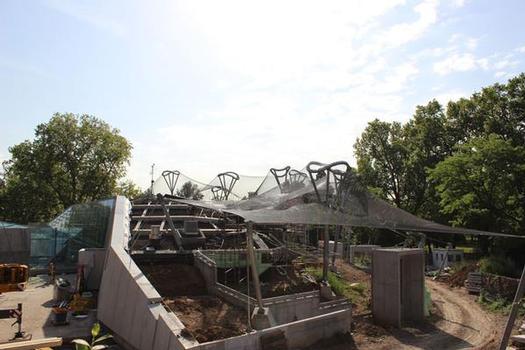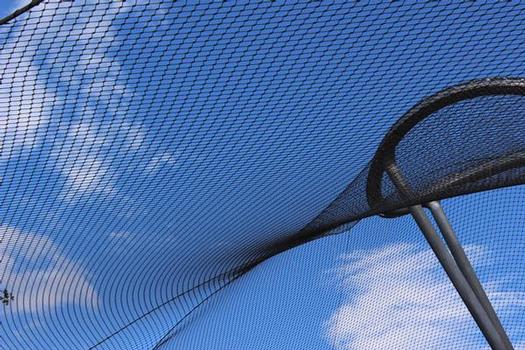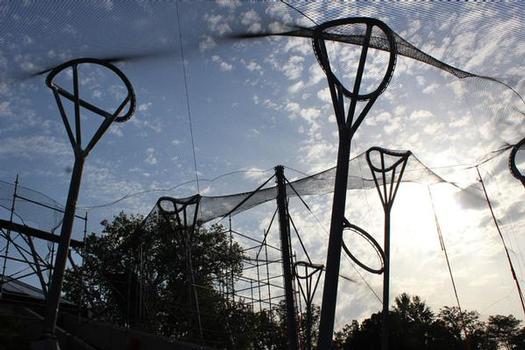General Information
Project Type
| Structure: |
Cable net |
|---|---|
| Function / usage: |
Zoological facility |
| Material: |
cable net: Steel structure building: Reinforced concrete structure |
Awards and Distinctions
| 2015 |
entry
for registered users |
|---|
Location
| Location: |
Bad Cannstatt, Stuttgart, Baden-Württemberg, Germany |
|---|---|
| Part of: | |
| Coordinates: | 48° 48' 22.95" N 9° 12' 5.16" E |
Technical Information
Materials
| building structure |
reinforced concrete
|
|---|---|
| columns |
steel
|
Ape House Wilhelma, Stuttgart
Task
Wilhelma, Stuttgart's zoological-botanical garden, is part of a park laid out in the 19th century as an English landscape garden, along the topography typical of the Stuttgart area, with a valley basin and steeply rising slopes.
The ape house, which dates from 1971, no longer met today's requirements in terms of animal husbandry, animal presentation and workplace guidelines, so a new building became necessary. The latest findings on the species-appropriate keeping of great apes had to be taken into account and had a significant influence on the design of the new enclosure. The original natural environment was to be adapted as far as possible and their accustomed way of life taken into account. Room dimensions and shapes, surfaces and lighting design play just as important a role as the apes' freedom of movement and design.
In the design concept for the new ape house, the scenic elements of mountain, valley and forest were taken up. Thus, the new enclosure, located on the topographic high point of the landscape park, forms an artificial ridge. The structure develops along an S-shaped line around the tree population worthy of preservation and seemingly pushes itself under the ground at the curved ends. This effect is achieved by the formation of two green and shell-like curved roof surfaces, which continuously flow into the adjacent landscape park. The indoor enclosures for the gorillas and bonobos are arranged underneath the two roof shells. The monolithic-looking concrete structure of the indoor enclosures in the "ridge" is contrasted by the open, landscaped layout of the outdoor enclosures, which are a natural continuation of the landscaped roofscape and are spanned in parts by a lightweight steel mesh structure.
Description of the construction
The obvious contrast of the light steel net construction of the outdoor enclosures to the massive reinforced concrete construction for the indoor enclosures is also reflected in the load-bearing effect of the two structures: the steel net as a tension-loaded and sagging structure, the solid construction as a compression-loaded and upward-curving structure. The common feature of these different types of structures is that their spatial curvature makes them particularly economical systems.
The vault-like roof structure for the indoor enclosures was realized with many flat, polygonal concrete slabs arranged at a flat angle to each other. This allows the vaulting effect to be utilized without having to realize a very elaborate, double-curved formwork and reinforcement.
To be able to realize the design idea of continuing the hilly landscape over the building, the structure had to be covered with a 50 cm thick layer of earth. Only this high structure allowed a seamless transition of the vegetation from the terrain over the roof. An optimized and material-saving transfer of these high loads could be achieved by the upward curved shape of the roof structure. On the side of the indoor enclosures, it transfers its compressive forces via walls to the floor slab. On the side of the visitors, the load transfer takes place via supports into the foundation. The horizontal component is short-circuited to the opposite side of the building via the floor slab.
The shape of the net surface, on the other hand, results from the static equilibrium condition that is established from the given boundary conditions, such as the location and height of the supports. The gentle curvatures of the net surface thereby form an intentional contrast to the folded reinforced concrete construction of the interior enclosures.
The 3,500 m² rope net of the bonobo enclosure spans an arc-shaped ground plan area of about 2,200 m², which is adapted to the curved shape of the adjacent indoor enclosure. Stretched over 13 high points with heights of up to 13 meters, an irregular, undulating roofscape is created.
The entire net construction is directly visible supporting structure. The rope net itself performs the task of delimiting the monkeys' movement space to the outside. At the same time, however, it is also the essential load-bearing component
Choice of building materials
The vault-like building structure for the indoor enclosures was realized as a reinforced concrete structure made of C30/37 and, in areas subject to higher compressive stresses, of C45/55 in conjunction with BSt SOOA reinforcing steel.
The tensile stressed rope net construction consists of blackened stainless steel ropes made of material 1.4401 with 3 mm diameter of the single round strand ropes. These individual ropes are joined by press clamps to form a net with diamond-shaped meshes of 50 or 60 mm mesh width.
The guy ropes of the edge supports of different diameters are made of stainless steel material 1.4401 with rope strengths of the individual ropes of min. 1450 N/mm².
The pylons are mainly made of S355 grade steel tubes. The account connections and footings of the inner pylons were made with GS-20 Mn 5 grade castings.
Special engineering achievement
The net structure, with a weight per unit area of 2.5 kg/m², and the solid structure, with a weight per unit area of the roof shell of 750 kglm², are as different in terms of their external appearance as they are in terms of the use and design requirements they must meet:
The net construction serves solely to delineate the bonobos' outdoor enclosure while providing them with as much space as possible. The necessary pylons were designed like trees, providing climbing opportunities for the monkeys and accomplishing their actual task of holding the net as if by accident. The material-minimized, durable and virtually maintenance-free facility is visually in the background for visitors, so that all attention can be devoted to the main attraction, namely the monkeys.
In contrast, the roof structure of the indoor enclosures, which is bent many times, serves not only as a dwelling for the apes. It is at the same time supporting structure for an artificially created, greened hill and is needed additionally as heat accumulator, in order to create an optimal interior climate for the primates. These diverse requirements led almost inevitably to this effective support structure, which was developed and optimized in close and good cooperation with the architects.
The special achievement in the structural design was to implement the basic design idea of the hilly landscape and the requirements resulting from the keeping of apes. Geometrically demanding but very efficient supporting structures were realized, which are visible at every point but at the same time appear natural and do their job in the background.
This has resulted in a facility with ample space for its animal inhabitants, guaranteeing excellent ape husbandry at Wilhelma for decades to come.
Explanatory report by wh-p GmbH Beratende Ingenieure Weischede, Herrmann und Partner for submission to the Ulrich Finsterwalder Ingenieurbaupreis 2015
Participants
Relevant Web Sites
There currently are no relevant websites listed.
Relevant Publications
- (2015): Wenn Tragwerk und Architektur miteinander verschmelzen - Das neue Menschenaffenhaus der Stuttgarter Wilhelmina. In: (2015): Ingenieurbaukunst 2016. Ernst & Sohn, Berlin (Germany), ISBN 9783433031261, pp. 106-113.
- About this
data sheet - Structure-ID
20065670 - Published on:
20/08/2013 - Last updated on:
21/01/2015









